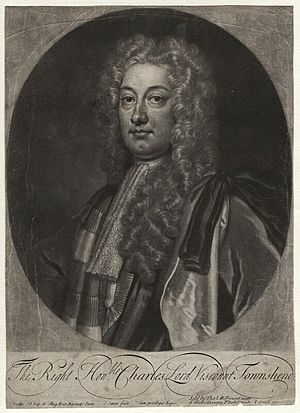Townshend ministry facts for kids
This article is about the government led by Charles Townshend. In September 1714, Charles Townshend, 2nd Viscount Townshend, was chosen by George I of Great Britain to be the Secretary of State for the Northern Department. This was a very important job. Until 1717, he was the main leader of the government, even though he wasn't officially called "Prime Minister." His government was made up of members of the Whig party. However, he later lost his top position. Other Whig leaders, who were his rivals, managed to get him moved to a less powerful role as Lord Lieutenant of Ireland. This caused a big disagreement and split within the Whig party that lasted until 1720.
Who Was in the Government?
The government, often called a "ministry" or "cabinet," is a group of important people who help the King or Queen run the country. They each have different jobs, like managing money or dealing with other countries. Here are some of the key people who served in Charles Townshend's government:
- The Viscount Townshend: He was the Secretary of State for the Northern Department from 1714 to 1716. This role involved handling relations with countries in northern Europe. He later became Lord Lieutenant of Ireland in 1717.
- The Lord Cowper: He was the Lord Chancellor from 1714 to 1717. The Lord Chancellor is a senior government official, often involved in legal matters.
- First Lord of the Treasury: This person was in charge of the country's money.
- The Earl of Halifax held this job from 1714 to 1715.
- The Earl of Carlisle took over in 1715.
- Then, Robert Walpole held the position from 1715 to 1717.
- Lord Privy Seal: This role involved keeping the King's private seal, which was used to approve important documents.
- The Marquess of Wharton held it from 1714 to 1715.
- The Earl of Sunderland held it from 1715 to 1716.
- Lord President of the Council: This person led the Privy Council, a group of advisors to the monarch.
- The Earl of Nottingham held this role from 1714 to 1716.
- The Duke of Devonshire took over from 1716 to 1717.
- Secretary of State for the Southern Department: This role handled relations with countries in southern Europe.
- James Stanhope held this job from 1714 to 1716.
- Paul Methuen held it from 1716 to 1717.
- Chancellor of the Exchequer: This person was responsible for the country's finances.
- Sir Richard Onslow held this job from 1714 to 1715.
- Robert Walpole took over from 1715 to 1717.
It's interesting to note that Robert Walpole held two important money-related jobs at the same time, as both First Lord of the Treasury and Chancellor of the Exchequer, between 1715 and 1717. Also, while serving as Lord Lieutenant of Ireland (1714–1717), Lord Sunderland was also the Lord Privy Seal for part of that time (1715–1716).
See Also


